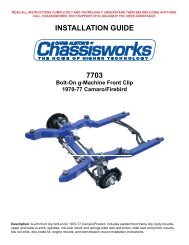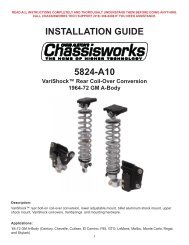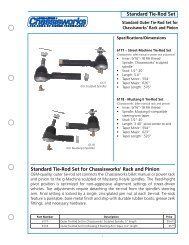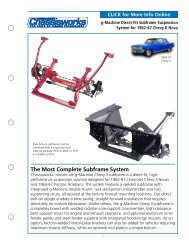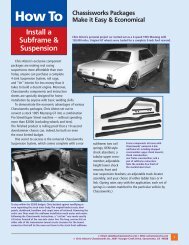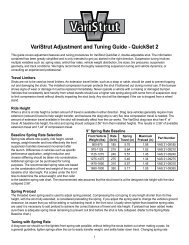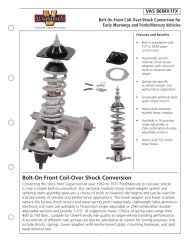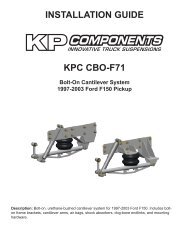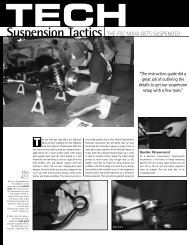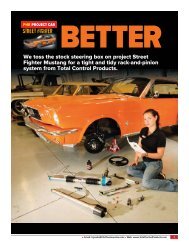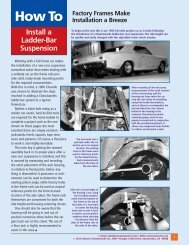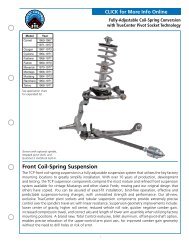Selecting a Rear Suspension - Chris Alston's Chassisworks
Selecting a Rear Suspension - Chris Alston's Chassisworks
Selecting a Rear Suspension - Chris Alston's Chassisworks
You also want an ePaper? Increase the reach of your titles
YUMPU automatically turns print PDFs into web optimized ePapers that Google loves.
of a 3/4-inch end. Plus, it’s made from a newaerospace material with strength equivalent to4130 chromemoly.Another factor is the diameter of the ladderbar’s tubing. The bottom bar tends to flex in areal high-horsepower or heavyweight car. Our1-1/4-inch bottom bars are almost impossibleto flex. To offset their slightly heavier weight,we use two 3/4-inch-shank rod ends with1/2-inch bolts at the rear. You don’t give upany strength, because you have two rod endsback there.Even with the giant front rod end, you haveto be very careful inspecting and replacing it.When you first install the rod ends, measurethem with a caliper. If they stretch even acouple thousandths, get rid of them. They needto be inspected frequently, especially in a heavyand/or very fast car. At the absolute minimum,it’s an annual throw-away part.Some manufacturers advertise that solid rodends in the front of the ladder bar will causebinding; however, since ladder bars for raceuse do not “roll,” installing spherical rod endswould only increase the possibility of breakage— definitely a bad idea.In a solid-rod-end car, you cannot run thefront bolt that holds the rearend to the frametight, because it pinches the bracket againstthe rod end, and binds it up. If you torque this5/8-inch bolt and squeeze these brackets, therearend won’t go up and down. What it does ispromptly break a front rod end off! However,track locaters that bolt onto the front ofladder bars now require that the bolt is tight;otherwise, the locater won’t locate the rearsuspension. <strong>Chassisworks</strong> solved this problemby going to a 3/4-inch-hole bracket with aspacer set. The spacer tightens against the sideof the rod end, but it has a 3/4-inch outside,so it will pivot in the bracket — allowing youto tighten the front bolt. If you keep it greased,it’s really free and really strong.For Pro Street applications, <strong>Chassisworks</strong>has developed a huge, aerospace-alloy,billet-steel ladder-bar rod end that uses largeurethane bushings. It’s strong enough for bigblockhorsepower.4-LINK ROD ENDSSpherical-type rod ends should be used in alllinks. The rearend actually rotates, and solidrod ends don’t allow that natural movement.A 4-link with solid ends will be much stiffer,making the car difficult to hook up. For dragracing 4-links, <strong>Chassisworks</strong> offers sets of eightrod ends in either mild steel or 4130 chromemoly.The 4130 units are twice as strong, andare absolutely mandatory for vehicles makinglots of horsepower, and/or carrying a lot ofweight, and/or running huge rear tires.For Pro Street applications, <strong>Chassisworks</strong>has developed a huge, aerospace-alloy, billetsteelrod end that uses large urethane bushings.It’s strong enough for big-block horsepower.SHOCK ABSORBERSToday’s basic rear-suspension setup uses aninexpensive coil-spring kit with light-valved,OEM-type shock absorbers. Our adjustableride-heightlower shock mount allows the homebuilder to be off a little in his calculations,and still get the car to ride where he wants.And there is some adjustment in that forperformance. Our kit uses the same coil springsthat we put in our Koni coil-over set. It’s a nice,compact unit that works well for the budgetconsciousguy. For about $230, you get acomplete set of shocks, springs, adjustableheightlower mounts and upper spring mounts.The next step up is to a true coil-over.The advantage here is mostly in the valving ofthe shock. What’s known as the single-internaladjustableKoni shock was specifically designedfor drag racing. You take it off and rotate it toadjust how hard the shock comes apart. Thisseparation, or extension, is the majority oftuning on a drag racing shock. Like anythingelse, if a shock has more adjustments, you canpossibly make it work better, because you havemore places you can put it. Internally adjustableKonis cost about $300 a pair, with springs.Our mounting kit is about $60, so the true-coiloverpackage is almost $130 more than thecoil-spring kit described above. The third stepup the “shock ladder” is the VariShock QuickSet1 externally adjustable, aluminum-bodied coilover.Since the extension setting of the shock iswhat controls a drag race car’s rear suspension,these shocks are the “best bang for your buck.”For about $420 a pair (with springs), you getthe external adjustment at two-thirds the priceof double-adjustable shocks.The ultimate drag racing shock is VariShock’sdouble-adjustable QuickSet 2. One knob at thebottom adjusts how hard the shock absorbercomes together; a second knob at the bottomsets how hard the shock pulls apart. Thesecost about twice as much as the internallySpherical rod ends (foreground)are offered in several mild-steeland chromemoly versions forcompetition 4-links. Larger, billet-steel rod ends with urethanebushings (background) areincluded with all Pro Street 4-links.adjustable SensiSet model, but we recommendthe QuickSet 2 to the racer who’s seriouslyinterested in both hooking up at launch andmaintaining high-speed stability at the big end.WHEELIE BARSThe two popular styles of wheelie bars useeither a flat bottom bar with a tubular upperbar; or tubular bars on both the bottom andtop. The flat-bottom design was a functionalwheelie bar in its day, but it’s old technologynow. It is inherently inconsistent in the way thealuminum bottom bar acts as a spring. When itgets up on the wheel, it gets some of its springby flexing the bottom bar, and some fromhaving an actual spring in the top. So you havethese two springs working together, and it’sdifficult to fine-tune and get good control.It also takes up more room under a car. In areal narrow, late-model, pro-type car, this is aserious issue. Plus, its mounting-bracket designprevents this type of wheelie bar from runningreal close to the ground, and bumper clearanceis an incredible problem on newer cars. Mostflat-type bars are also too short, so they tendto unload the tire. A 44-inch bar may be realcommon, but it’s too violent against the tireto work well. The car may not wheelstand, butyou’re not getting the optimum result, either.You want a wheelie bar at least 50 inches long.Dual-tube wheelie bars are found in all realrace cars because they’re a little lighter; theyoffer better bumper clearance; and they resultin a more solid assembly, making them easierto fine-tune. On dual-tube wheelie bars, it isimportant to “X” the top strut — not thebottom. By “X”-ing the top, you have more jackclearance. Plus, designs that only “X” on thebottom half will break the lower tube, becausethe partial “X” overloads the tube in the center.This will only happen in hard-launching, fastcars, but why take a chance?Now you must choose between a springloadedor unsprung design. On a car thatwheelstands hardly at all, you can get awaywith our unsprung version, because you’re notviolently on the bar that hard. But if you havea car that seriously wheelstands, you want thespring-loaded bar to give that extra bit ofcontrol. The difference in price is about $50.A spring-loaded bar may seem simple, but it’sactually quite sophisticated. Adjustments haveto be made very carefully. Most racers makeway too coarse of an adjustment; the way theyget a car not to wheelstand excessively is tomake it unload the tire. It’s a fine line to get thewheelie bars to delicately keep the car on theground without unloading the tire, particularlywhere it counts most: in the first 60 feet. Youneed a bar that’s very stable and lets you makefine adjustments. That’s why dual-tube, springloadedwheelie bars have become the norm forpro race cars Email: sales@cachassisworks.com Web: cachassisworks.com <strong>Chris</strong> Alston’s <strong>Chassisworks</strong> Inc., 8661 Younger Creek Drive, Sacramento, CA 95828ProductTech-004



